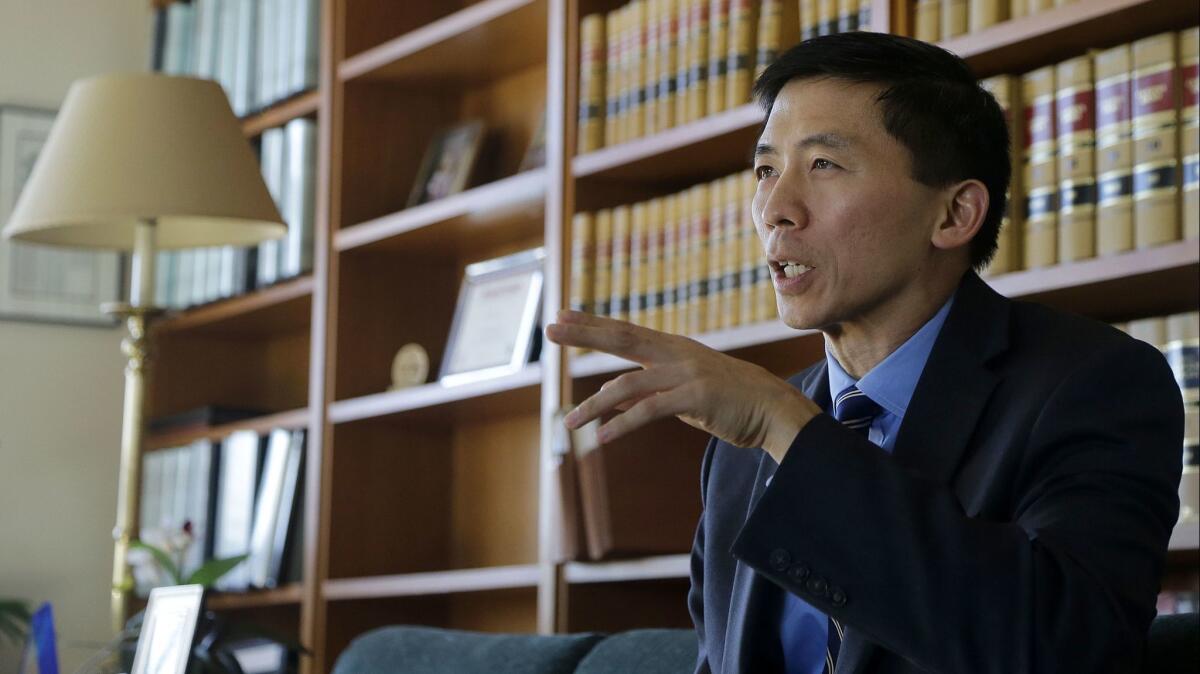California justice calls for new rules on eyewitness identification in court

- Share via
A California Supreme Court justice, dissenting Monday in a death penalty decision, called for new rules to curb inaccurate eyewitness identification, a leading cause of wrongful convictions.
The dissent came in a case in which the court decided 5 to 2 to uphold the death sentence of Ennis Reed, convicted of killing two people in Compton.
Justice Goodwin Liu wrote the dissent, calling on the courts to better police eyewitness testimony. Justice Leondra Kruger did not sign Liu’s dissent but wrote separately, saying she was dissenting in Reed’s case for some of the reasons Liu cited.
Reed was sentenced to death in 1999 for killing Amarilis Vasquez and Paul Moreland in separate incidents.
Evidence at Reed’s death penalty trial showed he had dropped out of school after seventh grade, when he was performing at the level of a third- or fourth-grader, and had been convicted in 1992 of attempted murder for driving a car in which a passenger shot someone from the vehicle.
In the appeal of his death penalty case, Reed, who is African American, argued that the prosecutor discriminated against African Americans in picking the jury and that the evidence, largely testimony by eyewitnesses, did not support the convictions.
Reed also challenged the eyewitness testimony. In the case of one of the witnesses, Reed was the only bald person in a six-photo array and the only person to appear in both the photos and the in-person lineup.
Justice Mariano-Florentino Cuéllar, writing the majority ruling, rejected Reed’s claims. Cuéllar cited a variety of reasons that justified the prosecutor’s decision to exclude some African Americans while keeping others.
The court majority also said the eyewitness identification was buttressed by evidence that placed Reed near the scene of one of the killings and with an individual whose last name matched someone police chased that night into a home that contained the murder weapon.
Moreover, the majority said, an eyewitness in one of the killings identified Reed in two lineups and at the preliminary hearing.
Liu, joined by Kruger, said the conviction had to be overturned because the trial judge failed in his legal responsibility to examine the prosecutor’s motives after Reed’s lawyer objected to the removal of several African American prospective jurors.
“As a result of the trial court’s error, we cannot be confident that Reed was convicted by a jury selected without regard to race,” Liu wrote.
Liu went further, though, stressing that the law was not keeping pace with the science on eyewitness identification.
The eyewitnesses in Reed’s case saw the assailant while they were under great stress, in poor lighting and at a distance, Liu said. They also were a different race from the perpetrator, and one of them did not identify Reed in a photo lineup until several months after the killing.
Citing an array of research, Liu said new jury instructions should be written to help jurors understand the problematic nature of eyewitness testimony and weigh its accuracy.
Law enforcement also can reduce the risk of inaccuracy, Liu wrote, by videotaping lineups and ensuring the operator of the lineup does not know which person is the suspect.
“But there is little that courts can do to induce law enforcement to adopt these practices unless courts themselves subject such evidence to greater scrutiny,” Liu said in a portion of the dissent that Kruger did not join.
He said the state high courts of Oregon and New Jersey have taken steps to try and ensure that trial judges better police eyewitness testimony and called on the Legislature and the Judicial Council, the policymaking body for the courts, to address the issue.
“This case provides another example of the problematic nature of eyewitness identification evidence, particularly where such evidence is the sole or principal evidence against the defendant,” Liu wrote.
Twitter: @mauradolan
More to Read
Sign up for Essential California
The most important California stories and recommendations in your inbox every morning.
You may occasionally receive promotional content from the Los Angeles Times.














